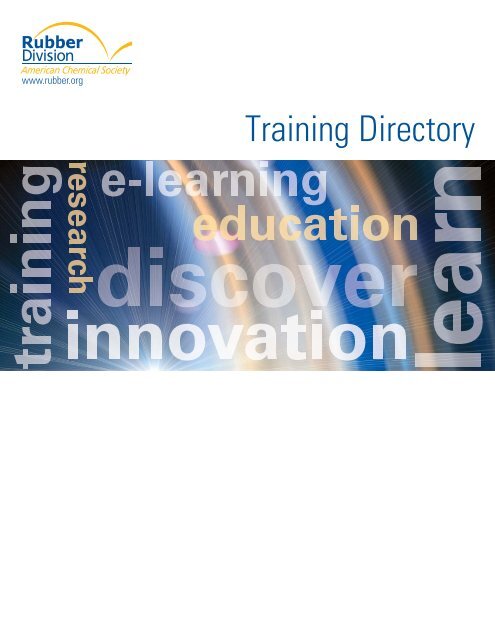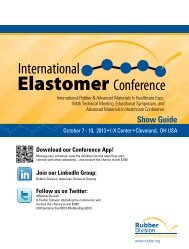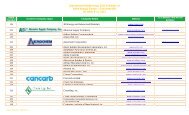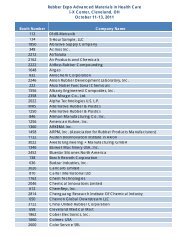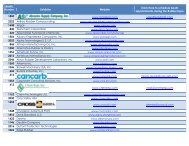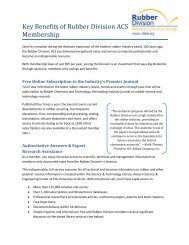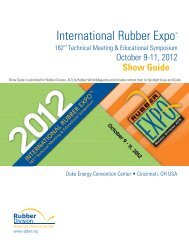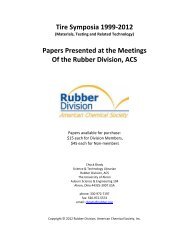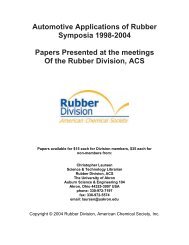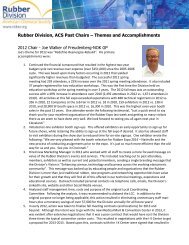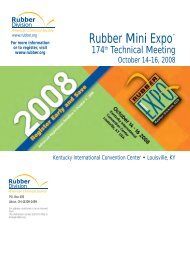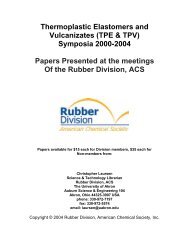Training Directory - Rubber Division
Training Directory - Rubber Division
Training Directory - Rubber Division
You also want an ePaper? Increase the reach of your titles
YUMPU automatically turns print PDFs into web optimized ePapers that Google loves.
www.rubber.org<br />
<strong>Training</strong> <strong>Directory</strong>
Table of Contents<br />
Online <strong>Training</strong> Courses ......................................3<br />
Manufacturing & Processing ............................. 4-8<br />
Properties, Analysis & Testing ..................... 9-12<br />
Products & Applications .............................. 13-16<br />
Environment, Health & Legislation ..................17<br />
Business ......................................................... 18-19<br />
www.rubber.org<br />
Key To Symbols<br />
Online Registration<br />
Certifi cate/CEUs Awarded<br />
On-site<br />
<strong>Rubber</strong> <strong>Division</strong>, ACS training programs are<br />
learning events, and a certificate and CEUs<br />
are awarded to participants upon successful<br />
completion of the program. No test is given<br />
and participants are not certified.<br />
E-learning<br />
International<br />
2 RUBBER DIVISON, ACS EDUCATION OPPORTUNITIES
<strong>Rubber</strong> <strong>Division</strong>, ACS Education Opportunities<br />
Basic <strong>Rubber</strong> Technology<br />
Recommended For:<br />
• People with little or no prior technical rubber industry background<br />
whose daily work now is connected with the rubber industry<br />
Associated Text:<br />
• Basic Elastomer Technology, edited by Drs. K. C. Baranwal and<br />
H. L. Stephens, 2000<br />
Course Topics:<br />
• Introduction to Polymer Science<br />
• The Compounding and Vulcanization of <strong>Rubber</strong><br />
• Fillers: Carbon Black and Nonblack<br />
• Processing and Vulcanized Tests<br />
• Physical Testing of Vulcanizates<br />
• Natural <strong>Rubber</strong><br />
• Styrene-Butadiene <strong>Rubber</strong>s<br />
and much more!<br />
CEUs: 5<br />
Intermediate <strong>Rubber</strong> Technology<br />
Recommended For:<br />
• People whose daily work involves the use of rubber and rubber-like<br />
materials. For the experienced individual, this course will serve<br />
as both a review and an update. Newer people to the fi eld will be<br />
able to use this course as a continuation of education after<br />
completing the Basic <strong>Rubber</strong> Technology course listed above.<br />
Associated e-Text:<br />
• Elastomer Technology: Special Topics edited by Drs. H. L. Stephens<br />
and K. C. Baranwal<br />
• Book chapters available via an online download<br />
Course Topics:<br />
• Elastomers and Their Usage<br />
• Physical Properties and Their Usage<br />
• Compound Analysis<br />
• Engineering Design<br />
• Processing Aids<br />
• Plasticizers<br />
• Vulcanization<br />
and much more!<br />
CEUs: 9<br />
Online <strong>Training</strong><br />
Courses<br />
Advanced <strong>Rubber</strong> Technology<br />
Recommended For:<br />
• This course is designed for highly motivated professionals. Special<br />
emphasis is placed on the theoretical, as well as the practical<br />
aspects of polymerization, polymer structure, rheology and rubber<br />
elasticity concepts and behavior.<br />
Associated Text:<br />
• Science and Technology of <strong>Rubber</strong>, edited by Drs. J. E. Mark,<br />
B. Erman and E. R. Eirich<br />
Course Topics:<br />
• <strong>Rubber</strong> Elasticity: Basic Concepts and Behavior<br />
• Polymerization<br />
• Structure Characterization in the Science and Technology<br />
of Elastomers<br />
• The Molecular Basis of <strong>Rubber</strong>-Like Elasticity<br />
• Dynamic Mechanical Properties<br />
• Rheological Behavior and Processing of Unvulcanized <strong>Rubber</strong><br />
and much more!<br />
CEUs: 12<br />
Costs For Each Of The Three Online Courses:<br />
• Members: $385.00 (plus shipping)<br />
• Non-members: $485.00 (plus shipping)<br />
If a company sends 10 or more of their employees at a time through online courses, we can offer a 10% discount<br />
on the total of those registrations.<br />
VISIT WWW.RUBBER.ORG/ONLINE-EDUCATIONAL-CLASSES FOR MORE INFORMATION OR TO REGISTER ONLINE. 3
MANUFACTURING & PROCESSING<br />
Compounding, Mixing, Curing<br />
and Testing of <strong>Rubber</strong><br />
12 hours<br />
CEUs: 1.2<br />
This two-day course covers an Introduction to Polymer Science:<br />
NR, SBR and Polybutadiene <strong>Rubber</strong>; and Introduction to<br />
Compounding: Mixing, Carbon Black, Vulcanization, Specialty<br />
Elastomers, Tack and Adhesion; and the Physical Testing of<br />
Elastomer Procedures and Signifi cance. There is also a group<br />
discussion and problem solving session.<br />
Anyone interested in an introductory seminar on rubber<br />
should attend.<br />
Introduction to <strong>Rubber</strong> Technology<br />
for Non-Technologists<br />
4 RUBBER DIVISON, ACS EDUCATION OPPORTUNITIES<br />
8 hours<br />
CEUs: .8<br />
If you are new to the industry, working in Engineering, Sales,<br />
Administration, Human Resources or any other non-technical<br />
area, and you’d like a very basic, easy to understand introduction<br />
to the jargon of the trade and what goes on in the factory and<br />
lab, then this one-day course is perfect for you. You won’t come<br />
out a rubber expert, but you will understand all the basics of the<br />
technology and the language of the business.<br />
The course material will cover:<br />
• What polymers are, how rubber is different from plastic<br />
• How recipes for rubber compounds are created and why<br />
• What’s involved in mixing, processing and vulcanizing rubber<br />
• Testing, specifying and quality control of rubber products<br />
Cure Chemistry for <strong>Rubber</strong><br />
7 hours<br />
CEUs: .7<br />
This course will be a comprehensive review on the chemistry of<br />
rubber curing. It will include sulfur curing along with the majority<br />
of the common and not so common curatives types. Next will be a<br />
section on sulfur donors and their effect on the curing chemistry.<br />
Then peroxide curing will be covered, including the common<br />
available peroxides with their advantages and disadvantages<br />
along with a short section on co-agents. Finally, there will be<br />
sections on unconventional cure systems including resins cures<br />
and other unique cure chemistries.<br />
Equipment Selection & Technical<br />
Evaluation<br />
8 hours<br />
CEUs: .8<br />
Our equipment analysis portfolio provides a thorough examination<br />
of injection molding equipment to meet the requirements of the<br />
client’s application. Clients gain a competitive edge during the<br />
equipment acquisition phase, ultimately improving build efficiency<br />
while maintaining cost control.<br />
<strong>Rubber</strong> Processing<br />
7 hours<br />
CEUs: .7<br />
This seminar will deal with both theory and its application to<br />
practice, and the text used with this seminar will give references<br />
to the literature, which will enable those interested to dig deeper<br />
into any specifi c topic. There will be sessions on: Raw Materials<br />
Acceptance and Testing; Mixing; Milling and Calendering;<br />
Extrusion; Molding; Curing; and Processability Testing.<br />
Elastomer Molding Technology<br />
8 hours<br />
CEUs: .8<br />
This seminar describes and compares important molding methods<br />
(compression, transfer and injection) for thermoseting elastomers<br />
(TSEs) with methods (injection and blow) for thermoplastic elastomers<br />
(TPEs). Injection in molding is emphasized because it is the major<br />
molding method common to both elastomers. Injection molding<br />
machines and their characteristics will also be described and<br />
compared. Finally, there will be a limited description of mold<br />
design for TSEs and TPEs.<br />
This introductory course will benefi t people involved in molding<br />
both types of elastomers, especially those transitioning from<br />
molding of one type of elastomer to another. Attendees with<br />
primarly a materials-related background will improve their<br />
understanding of molding processes and the effect of mold design<br />
on molded products. Process and design managers will better<br />
understand the effect and importance of these factors<br />
on the overall molding operation.<br />
Attendees will improve their understanding of molding behavior<br />
of TSEs and TPEs and thus improve and better control their<br />
elastomer molding operations. The interdisciplinary approach<br />
used will assist them in understanding molding as an integrated<br />
operation consisting of materials, processes and design. The book<br />
“Elastomer Molding Technology” authored by John Sommer will<br />
be distributed and used in conjunction with the seminar.
Mixing and Testing for Compounding<br />
Consistency<br />
6 hours<br />
CEUs: .6<br />
This seminar will provide specifi c details describing control of<br />
the mixing process and the testing procedures to measure the<br />
effectiveness of this control. Compound properties and quality<br />
are always the fi rst concerns of product designers, producers<br />
and users – the product must meet performance specifi cations.<br />
However, once quality criteria have been determined, the job of<br />
the mixer is to guarantee and deliver a compound with uniformity<br />
and consistency meeting these specifi cations. Attendees will gain<br />
or expand their understanding of this process amongst others.<br />
“Mixing and Testing for Compound Consistency” will provide:<br />
• material control concepts.<br />
• mixing techniques.<br />
• tests designed to relate to compound consistency.<br />
• statistical treatment of mixing and test data.<br />
This seminar will benefi t mixing managers and supervisors,<br />
quality control engineers, and laboratory managers and supervisors.<br />
Introduction to Compounding<br />
and Testing of Elastomers<br />
8 hours<br />
CEUs: .8<br />
This seminar will present an overview of compounding elastomers.<br />
It will present a description and review of the functionality of the<br />
various compounding ingredients used to formulate a rubber<br />
compound, their advantages and disadvantages, in order to<br />
achieve a desired level of compound performance properties.<br />
Materials discussed include elastomers, fi llers, curing agents,<br />
plasticizers and antioxidants.<br />
This is an applied seminar which emphasizes practical approaches<br />
to real world compounding problems. Theory and mechanisms<br />
are presented where they are helpful to allow the compounder to<br />
develop a model to predict behavior and responses.<br />
The objectives of this seminar:<br />
• provide overview of practical aspects of compounding<br />
elastomers<br />
• provide help in selecting elastomers<br />
• provide opportunities for one-on-one dialog beyond<br />
general class interest<br />
• utilize class expertise as a resource<br />
• provide references/contacts for you to use as future<br />
questions arise<br />
<strong>Rubber</strong> Mixing: Current and<br />
Future Technology<br />
4 hours<br />
CEUs: .4<br />
This seminar will show the compounder the tools that are available<br />
for use to control the rubber mixing process. Issues such as<br />
quality of the raw materials, intermediates, mixing process and<br />
the final compound will be discussed. The ultimate goal of this<br />
session is to provide exposure to the tools to allow the rubber<br />
compound manufacturer to show batch-to-batch consistency.<br />
The <strong>Rubber</strong> Mixing Seminar will include:<br />
• a session on the influence of various mixing parameters<br />
such as rotor design, rotor speed and material addition<br />
schemes on the mixing of rubber and some factors and their<br />
affect on material uniformity/consistency.<br />
• a best practices discussion of the mixing operation.<br />
• an outlook to future mixing technology.<br />
This seminar will benefit mixing managers and supervisors, quality<br />
control engineers, and laboratory managers and supervisors.<br />
The ultimate goal of this session is to provide exposure to the<br />
tools that will allow the rubber compound manufacturer to<br />
improve batch-to-batch consistency.<br />
Key To Symbols<br />
Online Registration<br />
Certifi cate/CEUs Awarded<br />
On-site<br />
E-learning<br />
International<br />
<strong>Rubber</strong> <strong>Division</strong>, ACS training programs are learning<br />
events, and a certificate and CEUs are awarded<br />
to participants upon successful completion of the<br />
program. No test is given and participants are<br />
not certified.<br />
MANUFACTURING & PROCESSING<br />
VISIT WWW.RUBBER.ORG/SEMINARS FOR MORE INFORMATION OR TO REGISTER ONLINE. 5
MANUFACTURING & PROCESSING<br />
Fundamentals of Color and<br />
Appearance<br />
7 hours<br />
CEUs: .7<br />
The objective of the Fundamentals of Color and Appearance<br />
course is to get a basic understanding of how to communicate<br />
and control color. Topics in this course include basic color<br />
vocabulary, color concepts on light sources, visual and numeric<br />
assessment, how an object interacts with color, and appearance<br />
and setting tolerances.<br />
Agenda:<br />
Basic Color Theory: object, observer, source<br />
Appearance: grain, gloss, texture and color<br />
Color Instruments<br />
Assessment: instrumental and visual<br />
Tolerancing<br />
Engineering with <strong>Rubber</strong>:<br />
An Introduction<br />
14 hours<br />
CEUs: 1.4<br />
This course will introduce engineers and others to the basics of<br />
elastomeric materials and their use as engineering materials.<br />
Day 1 – <strong>Rubber</strong> As An Engineering Material<br />
Introduction - What Polymers Are, How They Behave<br />
Elastomers - What Makes Them Up, How They Differ<br />
From Plastics<br />
<strong>Rubber</strong> Compounds - What Are They?<br />
Properties of <strong>Rubber</strong> - Their Standard Characteristics<br />
Processing <strong>Rubber</strong> - Making the Product<br />
Bonding - Sometimes Essential<br />
Engineering Properties - Flexing, Environmental Resistance, Life<br />
Dynamic Properties - Stress/Strain Responses, Test Methods<br />
Quality Control - How to Know It’s Right<br />
Specifi cations - What They Mean and Don’t Mean<br />
Day 2 – Product Design Considerations<br />
Introduction to Design Applications<br />
<strong>Rubber</strong> as an Engineering Material<br />
Vibration Isolation/Shock Absorption<br />
Load Bearing Applications<br />
Seals<br />
Dynamic Mechanical Properties<br />
Stiffness<br />
Incompressibility and Shape Factor<br />
Linear vs. Non-Linear - Linear/stiffening/Buckling (Softening)<br />
Modulus - Frequency/Strain/Temperature<br />
Damping<br />
Definitions<br />
Transmissibility<br />
Compression Set/Drift/Relaxation<br />
Component Design<br />
Shear Mount<br />
Bending Effects<br />
Compression Mount<br />
Tube Form – Radial/Torsional/Cocking<br />
Parallel vs. Serial Mountings<br />
Use of Shims in Laminates<br />
Inclined Mountings<br />
Internal Heat Generation<br />
Fatigue Considerations<br />
Vibration Isolation<br />
Focalized Systems<br />
Shock Isolation<br />
Dynamic Environments<br />
Practical Design Details<br />
Design for uniform stress<br />
Dimensional tolerances<br />
Installation<br />
Causes of Failure<br />
Typical Mountings<br />
Flexible Couplings<br />
Seals<br />
6 RUBBER DIVISON, ACS EDUCATION OPPORTUNITIES
Chemistry and Technology of<br />
Polymeric Materials Used in<br />
Medical Device<br />
8 hours<br />
CEUs: .8<br />
The course begins with an overview of the FDA systems,<br />
terminology and guidance documents for: classifi cations of<br />
devices, obtaining FDA approvals and pre-clinical testing,<br />
including biocompatibility and biodurability testing. Included by<br />
example in the foregoing and throughout the course are a broad<br />
range of medical devices, which are manufactured wholly or<br />
substantially from elastomeric and plastic polymeric materials.<br />
These include medical latex items such as: gloves, catheters,<br />
condoms; urethane, silicone, polyamide and polyolefi n catheters;<br />
thermoplastic elastomeric blood tubing; syringes and associated<br />
accessories; UHMW and polyurethane orthopedic implants;<br />
plastic bottles, packaging and closures; and others.<br />
Key properties, chemical characteristics, and testing and analytical<br />
methods related to requisite performance characteristics of<br />
materials used in a range of products are discussed. Finally,<br />
the course reviews methods of material modifi cation through<br />
chemical backbone modifications, surface treatments, incorporation<br />
of nano materials to achieve properties such as anti-microbial<br />
properties, electrical conductivity, improved blood compatibility<br />
and/or improved biodurabilty.<br />
Those Who Should Attend:<br />
This is intended as an introductory course for materials,<br />
quality and engineering personnel who have limited knowledge<br />
of rubber and plastic materials used in medical devices. The<br />
course may also be useful to management or sales professionals<br />
new to the medical device field. There are no suggested technical<br />
pre-requisites for this course, one should need only have a<br />
general knowledge of rubber and plastics terminology to derive<br />
a signifi cant benefi t.<br />
Compounding Of Fluoroelastomers<br />
2 hours<br />
CEUs: .2<br />
This class will give a brief introduction to the compounding of<br />
fluoroelastomers (FKMs). FKMs are high performance elastomers<br />
well noted for their heat and chemical resistance. Topics covered<br />
will include selection of the proper fl uoroelastomer polymer, cure<br />
systems, compounding ingredients, processing, markets and<br />
applications.<br />
Chemistry and Technology of<br />
Polyurethane Elastomers<br />
4 hours or 8 hours<br />
CEUs: .4 or .8<br />
The course focuses on the fundamentals of elastomeric<br />
polyurethanes such as those used in coatings adhesives,<br />
sealants or elastomers (“CASE”). The course includes<br />
identification of major raw materials, an introduction to polymer<br />
chemistry and chemical structure-property relationships in<br />
elastomeric polyurethanes. Testing and analysis techniques,<br />
typical formulary and key processing methods are discussed in the<br />
context key markets such as medical device, oil fi eld, materials<br />
handling, architectural, and materials handling applications.<br />
Those Who Should Attend:<br />
Product engineers, managers, quality professionals and Jr. or<br />
Sr. level chemists. Suggested pre-requisites include general<br />
technical aptitude and general familiarity of technical terminology<br />
related to chemistry and rubber or plastic materials.<br />
Course Outline:<br />
1. Introduction: CASE market overview<br />
2. Polymer and functional group chemistry of polyurethanes<br />
3. Structure-property relationships and key raw materials<br />
4. Testing and analytical methods<br />
5. Processing Methods<br />
6. Case examples of typical polyurethane formulary.<br />
MANUFACTURING & PROCESSING<br />
<strong>Rubber</strong> <strong>Division</strong>, ACS training programs are learning<br />
events, and a certificate and CEUs are awarded<br />
to participants upon successful completion of the<br />
program. No test is given and participants are<br />
not certified.<br />
VISIT WWW.RUBBER.ORG/SEMINARS FOR MORE INFORMATION OR TO REGISTER ONLINE. 7
MANUFACTURING & PROCESSING<br />
Engineering with <strong>Rubber</strong><br />
7 hours<br />
CEUs: .7<br />
This course is specifi cally prepared for engineers who are not<br />
especially familiar with elastomers and their engineering<br />
properties. The basics of elastomer chemistry and processing<br />
will be presented, after which a more detailed examination<br />
of engineering properties and the behavior of elastomers in<br />
engineering applications will be examined. The goal of the<br />
instruction is to fi rst help engineers understand the underlying<br />
chemistry and processing of elastomers. Second, to learn what<br />
kind of engineering properties characterize elastomers and how<br />
those properties may be best utilized in engineering applications.<br />
Silicone Basics<br />
4 hours<br />
CEUs: .4<br />
This course will cover the following topics:<br />
• Silicone Characteristics and Benefi ts<br />
• Different Types (focus primarily on VMQ,<br />
not fl uro or phenyl)<br />
• How it is Made<br />
• Why it is Different Than Other Materials<br />
• Curing<br />
• Silica Powders<br />
• Additives for Different Properties and Applications<br />
• HCR Processing<br />
• LSR Differences – Properties and Processing<br />
• Q&A<br />
Introduction to Dispersions<br />
4 hours<br />
CEUs: .4<br />
This course will start with a detailed explanation about how<br />
dispersion is accomplished in rubber, including both liquids and<br />
solids. Next, each type of dispersion will be studied, including<br />
the common carriers and their capabilities. When discussing the<br />
polymer bound dispersion, several polymer types and combination<br />
will be examined. Finally, each type of dispersion will be explored<br />
as to their benefi ts and limitations.<br />
Internal Mixers and Mixing<br />
Parameters<br />
6 hours<br />
CEUs: .6<br />
This presentation covers a number of topics dealing with Internal<br />
Mixers and Mixing Parameters (the things that affect rubber mixing).<br />
It starts off with a brief history of mixing equipment, goes into<br />
what an internal mixer is and some of its different options. It<br />
covers the different types of rotors and how they differ, then<br />
spends a great deal of time looking into the infl uence of various<br />
mechanical and non-mechanical parameters and the effects they<br />
have on rubber mixing, production uniformity, wear and damage,<br />
the mixing process. It fi nishes with actual examples of problems<br />
encountered in the fi eld, what caused them and how they were<br />
resolved.<br />
Introduction to <strong>Rubber</strong> Technology<br />
for Non-Technologists<br />
Webinar<br />
If you are new to the industry, working in Engineering, Sales,<br />
Administration, Human Resources or any other non-technical<br />
area, and you’d like a very basic, easy to understand introduction<br />
to the jargon of the trade and what goes on in the factory and lab,<br />
then this 60-minute webinar is perfect for you. You won’t come<br />
out a rubber expert, but you will understand all the basics of the<br />
technology and the language of the business.<br />
8 RUBBER DIVISON, ACS EDUCATION OPPORTUNITIES
Selecting The Right Elastomer<br />
For Your Sealing Application<br />
2 hours<br />
CEUs: .2<br />
We will review the different elastomers and how they<br />
compare to each other. We will look at chemical compatibility,<br />
thermal properties and mechanical properties of elastomers<br />
used in sealing applications. Also discussed will be how to<br />
specify elastomers for your application, service conditions to<br />
consider and ‘cost vs value’ in selecting an elastomer.<br />
Chemical Compatibility Testing<br />
(and Interpreting Chemical<br />
Resistance Charts)<br />
2 hours<br />
CEUs: .2<br />
We will review chemical compatibility testing of elastomers and<br />
look at some of the different resources being used in the industry.<br />
Topics covered will include a review on the different elastomers<br />
and how monomer composition can effect chemical resistance,<br />
polymer selection and how compounding can effect chemical<br />
resistance. We’ll review some of the chemical resistance charts<br />
being used and try to answer some frequently asked questions<br />
on chemical resistance.<br />
Chemistry and Technology of<br />
Functional Coatings for Medical<br />
Devices<br />
4 hours<br />
CEUs: .4<br />
The course focuses on coatings and other secondary treatments<br />
of medical devices where the coating or treatment is intended<br />
to impart; anti-static, low friction, low wear, anti-microbial, antithrombogenic,<br />
or other functional property not inherent in the<br />
devices material of construction. The discussion focuses primarily<br />
on polymeric substrates such as catheters, introducers, blood<br />
pumps, orthopedic devices, wound care, and other implantable<br />
and non-implantable devices. Technologies discussed include;<br />
pharma based systems such as heparin and antibiotic types;<br />
hydrophilics based on PVP, PEG, PEO type structures; biomimetics<br />
and other polymer surfactants; silver and ceramic based systems;<br />
and fluoro and silicone modifi ers.<br />
Those Who Should Attend:<br />
Product engineers, managers, quality professionals and Jr. or<br />
Sr. level chemists. Suggested pre-requisites include general<br />
technical aptitude and general familiarity of technical terminology<br />
related to chemistry and rubber or plastic materials.<br />
Course Outline:<br />
1. Introduction and market overview<br />
2. Overview of physics, chemistry and/or physiology of anti-stats,<br />
antimicrobials, anti-thrombogenic treatments.<br />
3. Chemistry and technology of commercially signifi cant systems.<br />
4. Review of emerging technologies.<br />
PROPERTIES, ANALYSIS & TESTING<br />
VISIT WWW.RUBBER.ORG/SEMINARS FOR MORE INFORMATION OR TO REGISTER ONLINE. 9
PROPERTIES, ANALYSIS & TESTING<br />
Compounding, Mixing, Curing<br />
and Testing of <strong>Rubber</strong><br />
12 hours<br />
CEUs: 1.2<br />
This two-day course covers an Introduction to Polymer<br />
Science: NR, SBR and Polybutadiene <strong>Rubber</strong>; Introduction to<br />
Compounding: Mixing, Carbon Black, Vulcanization, Specialty<br />
Elastomers, Tack and Adhesion; and the Physical Testing of<br />
Elastomer Procedures and Signifi cance. There is also a group<br />
discussion and problem solving session.<br />
Anyone interested in an introductory seminar on rubber<br />
should attend.<br />
Testing of <strong>Rubber</strong>: Selecting,<br />
Performing and Interpreting<br />
ASTM <strong>Rubber</strong> Test Methods<br />
8 hours<br />
CEUs: .8<br />
Be sure to attend this two-day seminar which reviews the most<br />
commonly used rubber test procedures in the rubber industry<br />
today. It also discusses the nature of tests, why the tests are<br />
performed, interoretation and how this information can be used<br />
to improve rubber fabrication. This course covers all the major<br />
physical and chemical tests, as well as various standard practices.<br />
The seminar is ideal for a wide variety of individuals including:<br />
rubber technologists, rubber chemists, compounders, process<br />
engineers, laboratory technicians, supervisors and managers,<br />
quality assurance managers and engineers, shop foremen,<br />
technical salespeople, rubber producers and users, or anyone with<br />
the need to understand these commonly used ASTM methods.<br />
Key To Symbols<br />
Online Registration<br />
Certifi cate/CEUs Awarded<br />
On-site<br />
E-learning<br />
International<br />
Mixing and Testing for Compounding<br />
Consistency<br />
6 hours<br />
CEUs: .6<br />
This seminar will provide specifi c details describing control of<br />
the mixing process and the testing procedures to measure the<br />
effectiveness of this control. Compound properties and quality<br />
are always the fi rst concerns of product designers, producers<br />
and users – the product must meet performance specifi cations.<br />
However, once quality criteria have been determined, the job of<br />
the mixer is to guarantee and deliver a compound with uniformity<br />
and consistency meeting these specifi cations. Attendees will gain<br />
or expand their understanding of this process amongst others.<br />
“Mixing and Testing for Compound Consistency” will provide:<br />
• material control concepts.<br />
• mixing techniques.<br />
• tests designed to relate to compound consistency.<br />
• statistical treatment of mixing and test data.<br />
This seminar will benefi t mixing managers and supervisors,<br />
quality control engineers and laboratory managers and supervisors.<br />
Introduction to Compounding<br />
and Testing of Elastomers<br />
8 hours<br />
CEUs: .8<br />
This seminar will present an overview of compounding elastomers.<br />
It will present a description and review of the functionality of<br />
the various compounding ingredients used to formulate a rubber<br />
compound, their advantages and disadvantages, in order to<br />
achieve a desired level of compound performance properties.<br />
Materials discussed include elastomers, fi llers, curing agents,<br />
plasticizers and antioxidants.<br />
This is an applied seminar which emphasizes practical approaches<br />
to real world compounding problems. Theory and mechanisms<br />
are presented where they are helpful to allow the compounder<br />
to develop a model to predict behavior and responses.<br />
The objectives of this seminar:<br />
• provide overview of practical aspects of compounding<br />
elastomers<br />
• provide help in selecting elastomers<br />
• provide opportunities for one-on-one dialog beyond<br />
general class interest<br />
• utilize class expertise as a resource<br />
• provide references/contacts for you to use as future<br />
questions arise<br />
10 RUBBER DIVISON, ACS EDUCATION OPPORTUNITIES
Failure Analysis of <strong>Rubber</strong> and Plastics<br />
by Physical and Chemical Methods<br />
4 hours<br />
CEUs: .4<br />
This is a materials testing and analysis course which covers<br />
a wide range of thermoset and thermoplastic elastomeric<br />
materials, as well as engineering plastic materials. The course<br />
is divided into four sections: Section 1 begins the course with a<br />
brief overview of polymeric materials based on typical properties<br />
as relate to intended end uses. Next in section 1, in order to<br />
provide a basis for chemical analysis, discussions of the<br />
basic chemical functional group concepts as related to the<br />
polymer backbone are presented. Sections 2 and 3 give a basic<br />
introduction to physical testing and chemical analysis methods<br />
respectively. Physical testing including: tensile and tear testing,<br />
abrasion testing, ozone and other environmental resistance test,<br />
stress crack testing and a range of predictive testing methods.<br />
Analytical and instrumental methods covered includes: polymer<br />
identifi cation by simple wet chemistry methods, as well as more<br />
advanced methods such as FT-IR, NMR, state of cure analysis,<br />
microscopic and X-ray analysis methods, and chromatographic<br />
methods for identifi cation of additive. Finally, section 4 presents<br />
a series of case studies related to a broad range of actual failure<br />
analysis including tires, cast polyurethane parts, medical devices,<br />
automotive parts, hose and tubing, sporting goods and the like.<br />
Those Who Should Attend:<br />
Materials and quality technicians and Jr level chemists looking<br />
to expand their knowledge and skill set related to testing and<br />
analysis. Product engineers, managers and quality professionals<br />
desiring to expand their knowledge of what tests or analysis to<br />
request and/or desiring better understanding of the signifi cance<br />
and interpretation of laboratory results. Pre-requisites; general<br />
technical aptitude and general familiarity of technical terminology<br />
related to rubber and plastic materials.<br />
Cure Chemistry for <strong>Rubber</strong><br />
7 hours<br />
CEUs: .7<br />
Introduction to <strong>Rubber</strong> Bonding<br />
7 hours<br />
CEUs: .7<br />
If your operations include or will include the bonding of rubber<br />
compounds to solid substrates (metals, plastics, etc.) and you<br />
want to learn about the chemistry, mechanics and overall<br />
methods for achieving and evaluating such bonds, this course<br />
will expose you to all those subjects and more.<br />
The course material will cover:<br />
• the history and evolution of rubber bonding.<br />
• test methods for rubber bonds and their meaning.<br />
• how various bond chemistries work and interact with<br />
vulcanization chemistry.<br />
• examples of bonding studies.<br />
• specialized new bonding technologies.<br />
• troubleshooting the bonding process.<br />
Introduction to Carbon Black:<br />
Manufacture, Testing and Influence<br />
on <strong>Rubber</strong> Compound Properties<br />
4 hours<br />
CEUs: .4<br />
This course will introduce the attendee to the basics of the most<br />
important filler used in rubber compounds. A brief history of carbon<br />
black will be provided from its original purpose as a pigment<br />
through the discovery of its substantial reinforcing properties in<br />
natural rubber compounds to its current status as the largest volume<br />
filler used in tires and most other rubber products today. The course<br />
will cover the following aspects of carbon black technology: the<br />
various methods of producing carbon black with most emphasis<br />
on the furnace process, colloidal, chemical and pellet property<br />
testing, dispersion testing, and the infl uence of carbon black<br />
structure and surface area properties on rubber compounds.<br />
PROPERTIES, ANALYSIS & TESTING<br />
This course will be a comprehensive review on the chemistry of<br />
rubber curing. It will include sulfur curing along with the majority<br />
of the common and not so common curatives types. Next will be a<br />
section on sulfur donors and their effect on the curing chemistry.<br />
Then peroxide curing will be covered, including the common<br />
available peroxides with their advantages and disadvantages<br />
along with a short section on co-agents. Finally, there will be<br />
sections on unconventional cure systems including resins cures<br />
and other unique cure chemistries.<br />
VISIT WWW.RUBBER.ORG/SEMINARS FOR MORE INFORMATION OR TO REGISTER ONLINE. 11
PROPERTIES, ANALYSIS & TESTING<br />
Chemistry and Technology of<br />
Polyurethane Elastomers<br />
4 hours or 8 hours<br />
CEUs: .4 or .8<br />
The course focuses on the fundamentals of elastomeric<br />
polyurethanes such as those used in coatings adhesives,<br />
sealants or elastomers (“CASE”). The course includes<br />
identifi cation of major raw materials, an introduction to polymer<br />
chemistry and chemical structure-property relationships in<br />
elastomeric polyurethanes. Testing and analysis techniques,<br />
typical formulary and key processing methods are discussed in the<br />
context key markets such as medical device, oil fi eld, materials<br />
handling, architectural, and materials handling applications.<br />
Those Who Should Attend:<br />
Product engineers, managers, quality professionals and Jr. or<br />
Sr. level chemists. Suggested pre-requisites include general<br />
technical aptitude and general familiarity of technical terminology<br />
related to chemistry and rubber or plastic materials.<br />
Course Outline:<br />
1. Introduction: CASE market overview<br />
2. Polymer and functional group chemistry of polyurethanes<br />
3. Structure-property relationships and key raw materials<br />
4. Testing and analytical methods<br />
5. Processing Methods<br />
6. Case examples of typical polyurethane formulary.<br />
Introduction to Dispersions<br />
4 hours<br />
CEUs: .4<br />
This course will start with a detailed explanation about how<br />
dispersion is accomplished in rubber, including both liquids and<br />
solids. Next, each type of dispersion will be studied, including<br />
the common carriers and their capabilities. When discussing the<br />
polymer bound dispersion, several polymer types and combination<br />
will be examined. Finally, each type of dispersion will be explored<br />
as to their benefi ts and limitations.<br />
Introduction to Design of<br />
Experiments<br />
Webinar<br />
If you are a compounder, chemist, process engineer, factory<br />
troubleshooter, manufacturing supervisor, research or technical<br />
manager, you should consider this seminar.<br />
This seminar focuses on:<br />
• Review of Basic Statistics<br />
• What are Designed Experiments<br />
Introduction to Design of<br />
Experiments<br />
8 hours or 16 hours<br />
CEUs: .8 or 1.6<br />
If you are a compounder, chemist, process engineer, factory<br />
troubleshooter, manufacturing supervisor, research or technical<br />
manager, you should consider this seminar.<br />
This seminar focuses on:<br />
• Review of Basic Statistics<br />
• What are Designed Experiments<br />
Key To Symbols<br />
Online Registration<br />
Certifi cate/CEUs Awarded<br />
On-site<br />
E-learning<br />
International<br />
<strong>Rubber</strong> <strong>Division</strong>, ACS training programs are learning<br />
events, and a certificate and CEUs are awarded<br />
to participants upon successful completion of the<br />
program. No test is given and participants are<br />
not certified.<br />
12 RUBBER DIVISON, ACS EDUCATION OPPORTUNITIES
Understanding the Global Chemical-<br />
Supply Chain to the <strong>Rubber</strong> Industry<br />
8 hours<br />
CEUs: .8<br />
This one-day course provides a current overview of the chemical<br />
supply chain for the rubber industry. This course also reviews the<br />
present and future international economics and its effects on<br />
this chemical supply chain to rubber producers, compounding<br />
ingredient manufacturers, custom mixers, rubber fabricators,<br />
molders, extruders and others. This course includes a 592 page<br />
textbook.<br />
By taking this course and using the textbook, the participant will<br />
understand the chemical connectivity of rubber compounding<br />
materials to their chemical feedstocks. On completion of this<br />
course, the participants should be able to directly link new<br />
commercial changes in 175 commonly used chemical feedstocks<br />
to hundreds of different rubber compounding ingredients.<br />
Course Outline:<br />
The course is divided into twelve sections:<br />
1. Introduction and Macroeconomics<br />
2. Strategic Raw Materials<br />
3. General Purpose Elastomers<br />
4. Specialty Elastomers<br />
5. Textile Reinforcing Materials and Their Adhesive Systems<br />
6. Thermoplastic Elastomers<br />
7. Polyurethane<br />
8. Carbon Black, Fillers, Reinforcing Agents and Coupling<br />
Agents<br />
9. Process Oils, Synthetic Ester Plasticizers and Processing Aids<br />
10. Curatives<br />
11. Antioxidants, Antiozonants, Tackifi ers, Flame Retardants<br />
and Blowing Agents<br />
12. Intermediate Feedstocks (includes the 30 vital<br />
intermediates, as well as 135 other critical chemical<br />
intermediates with information regarding availability)<br />
Chemistry and Technology of<br />
Polymeric Materials Used in<br />
Medical Device<br />
8 hours<br />
CEUs: .8<br />
The course begins with an overview of the FDA systems,<br />
terminology and guidance documents for: classifi cations of<br />
devices, obtaining FDA approvals and pre-clinical testing,<br />
including biocompatibility and biodurability testing. Included by<br />
example in the foregoing and throughout the course are a broad<br />
range of medical devices, which are manufactured wholly or<br />
substantially from elastomeric and plastic polymeric materials.<br />
These include medical latex items such as: gloves, catheters,<br />
condoms; urethane, silicone, polyamide and polyolefi n catheters;<br />
thermoplastic elastomeric blood tubing; syringes and associated<br />
accessories; UHMW and polyurethane orthopedic implants;<br />
plastic bottles, packaging and closures; and others.<br />
Key properties, chemical characteristics, and testing and analytical<br />
methods related to requisite performance characteristics of<br />
materials used in a range of products are discussed. Finally,<br />
the course reviews methods of material modifi cation through<br />
chemical backbone modifications, surface treatments, incorporation<br />
of nano materials to achieve properties such as anti-microbial<br />
properties, electrical conductivity, improved blood compatibility<br />
and/or improved biodurabilty.<br />
Those Who Should Attend:<br />
This is intended as an introductory course for materials, quality<br />
and engineering personnel who have limited knowledge of rubber<br />
and plastic materials used in medical devices. The course may<br />
also be useful to management or sales professionals new to<br />
the medical device fi eld. There are no suggested technical<br />
pre-requisites for this course, one should need only have a<br />
general knowledge of rubber and plastics terminology to derive<br />
a significant benefi t.<br />
PRODUCTS & APPLICATIONS<br />
VISIT WWW.RUBBER.ORG/SEMINARS FOR MORE INFORMATION OR TO REGISTER ONLINE. 13
PRODUCTS & APPLICATIONS<br />
Introduction to Dispersions<br />
4 hours<br />
CEUs: .4<br />
This course will start with a detailed explanation on how dispersion<br />
is accomplished in rubber, including both liquids and solids.<br />
Next, each type of dispersion will be studied, including the<br />
common carriers and their capabilities. When discussing the<br />
polymer bound dispersion, several polymer types and combination<br />
will be examined. Finally, each type of dispersion will be explored<br />
as to their benefi ts and limitations.<br />
Chemical Structures and<br />
Viscoelasticity of <strong>Rubber</strong><br />
4 hours<br />
CEUs: .4<br />
This course is designed to focus on the chemistry of rubber and<br />
the other compound ingredients and their effects on viscoelasticity<br />
rather than the mathematical models and laboratory methods<br />
of measuring rubber viscoelasticity. The viscoelastic models,<br />
theories and defi nitions are covered, but the main focus is on<br />
the rubber compounding side. The viscoelastic properties of<br />
non-tire mechanical goods and tires are discussed, versus their<br />
performance properties.<br />
Course Outline:<br />
1. Viscoelastic Theory – Elastic and Viscous Behavior<br />
a. Hooke’s Law<br />
b. Newton Dashpot Model<br />
c. Brownian Motion<br />
d. Maxwell Model<br />
e. Kelvin-Voigt Model<br />
2. Elastomer Phases with Temperature Change<br />
a. Glassy Region<br />
b. Glass Transition Region (Tg)<br />
c. <strong>Rubber</strong> Region<br />
d. Flow Region<br />
e. Time-Temperature Superposition Theory<br />
3. Viscoelastic Properties Defi nitions<br />
a. Elastic Modulus<br />
b. Viscous Modulus<br />
c. Tan Delta<br />
d. Complex Modulus<br />
e. Loss Compliance<br />
4. Laboratory Measurement of Viscoelastic Properties<br />
5. Laboratory Viscoelastic Properties for Non-tire <strong>Rubber</strong><br />
Applications<br />
6. Laboratory Viscoelastic Properties for Tire Applications<br />
7. Elastomer Chemical Structure and Viscoelastic Properties<br />
a. Elastomer Backbone Flexibility<br />
b. Bulkiness of the Side Groups<br />
c. Steric Hindrance<br />
d. Flexibility of Side Groups<br />
e. Symmetry of Side Groups<br />
f. Homogeneous Versus Heterogeneous Elastomers<br />
g. Molecular Weight<br />
h. Elastomer Branching<br />
i. Polymer Chemical Modification<br />
8. Common <strong>Rubber</strong> Chemical Structures and Glass Transition<br />
Temperatures<br />
a. SBR, styrene butadiene rubber<br />
b. BR, butadiene rubber<br />
c. EPDM, ethylene propylene diene rubber<br />
d. IIR, CIIR, CIIR, butyl, bromobutyl and chlorobutyl rubbers<br />
e. NBR, HNBR, XNBR, butadiene acrylonitrile rubbers<br />
f. CR, polychloroprene rubber<br />
g. CSM, chlorosulfonated polyethylene rubber<br />
h. ECO, epichlorohydrin rubber<br />
i. ACM, polyacrylic rubber<br />
j. MQ, VMQ, PMQ, PVMQ, FVMQ, silicone rubbers<br />
k. AEM, ethylene acrylic rubber<br />
l. FKM, fluorocarbon rubber<br />
9. Non-rubber <strong>Rubber</strong> Compound Ingredients and Viscoelastic<br />
Properties<br />
a. Carbon Black<br />
b. Mineral Fillers<br />
c. Plasticizers, Oils and Process Aids<br />
10. Vulcanization System and Viscoelastic Properties<br />
Key To Symbols<br />
Online Registration<br />
Certifi cate/CEUs Awarded<br />
On-site<br />
E-learning<br />
International<br />
14 RUBBER DIVISON, ACS EDUCATION OPPORTUNITIES
Material Considerations for<br />
Medical Devices and<br />
Pharmaceutical Products<br />
7 hours<br />
CEUs: .7<br />
This course is designed for engineers, chemists, material<br />
designers and supply chain specialists who are interested in<br />
learning more about materials that are used in pharmaceutical<br />
applications. There is a variety of regulations and expectations for<br />
these materials. After an overview of these is presented, in-depth<br />
training will focus on the selection and qualifi cation of materials.<br />
Learning objectives for this course include:<br />
• developing an understanding of regulatory and industry<br />
expectations for materials used in pharmaceutical<br />
applications.<br />
• learning how to use various tools to effectively select<br />
and test materials.<br />
• becoming familiar with practical approaches to meet<br />
regulatory and industry expectations.<br />
Cure Chemistry for <strong>Rubber</strong><br />
7 hours<br />
CEUs: .7<br />
This course will be a comprehensive review on the chemistry of<br />
rubber curing. It will include sulfur curing along with the majority<br />
of the common and not so common curatives types. Next will be a<br />
section on sulfur donors and their effect on the curing chemistry.<br />
Then peroxide curing will be covered, including the common<br />
available peroxides with their advantages and disadvantages<br />
along with a short section on co-agents. Finally, there will be<br />
sections on unconventional cure systems including resins cures<br />
and other unique cure chemistries.<br />
PRODUCTS & APPLICATIONS<br />
Silicone Basics<br />
4 hours<br />
CEUs: .4<br />
This course will cover the following topics:<br />
• Silicone Characteristics and Benefi ts<br />
• Different Types (focus primarily on VMQ,<br />
not fl uro or phenyl)<br />
• How it is Made<br />
• Why it is Different Than Other Materials<br />
• Curing<br />
• Silica Powders<br />
• Additives for Different Properties and Applications<br />
• HCR Processing<br />
• LSR Differences – Properties and Processing<br />
• Q&A<br />
<strong>Rubber</strong> <strong>Division</strong>, ACS training programs are learning<br />
events, and a certificate and CEUs are awarded<br />
to participants upon successful completion of the<br />
program. No test is given and participants are<br />
not certified.<br />
VISIT WWW.RUBBER.ORG/SEMINARS FOR MORE INFORMATION OR TO REGISTER ONLINE. 15
PRODUCTS & APPLICATIONS<br />
<strong>Rubber</strong> Bonding - Intro to Application<br />
14 hours<br />
CEUs: 1.4<br />
If your operations include or will include the bonding of rubber<br />
compounds to solid substrates (metals, plastics, etc.) and you<br />
want to learn about the chemistry, mechanics and overall<br />
methods for achieving and evaluating such bonds, this course<br />
will expose you to all those subjects and more. You will progress<br />
through learning the theories of bonding to detailed discussions<br />
of actual factory practices for consistent, durable bonds.<br />
The fi rst day of the course will cover:<br />
• the history and evolution of rubber bonding.<br />
• test methods for rubber bonds and their meaning.<br />
• how various bond chemistries work and interact with<br />
vulcanization chemistry.<br />
• examples of bonding studies.<br />
• specialized new bonding technologies.<br />
• basic troubleshooting the bonding process.<br />
The second day will progress into much more detailed<br />
examination of the nuts and bolts of:<br />
• the many varieties of available primers and adhesives.<br />
• selection of particular adhesives for both different types of<br />
elastomers and different molding methods.<br />
• a thorough examination of the kinds of surface preparations<br />
needed to optimize bond strength.<br />
• discussion of various application methods for adhesives<br />
and the required equipment.<br />
• more discussion of bond testing and evaluation.<br />
• analysis of poor or failed bonds and how it can lead to<br />
discovery of a robust bonding technique.<br />
Material Selection<br />
4 hours or 8 hours<br />
CEUs: .4 or .8<br />
We can review your existing part design or new product for<br />
robustness while suggesting alternate materials for cost<br />
reduction. We provide suggestions that will help you mold<br />
better arts, reduce scrap rates and ultimately lead to a less<br />
costly launch of a new product.<br />
<strong>Rubber</strong> <strong>Division</strong>, ACS training programs are learning<br />
events, and a certificate and CEUs are awarded<br />
to participants upon successful completion of the<br />
program. No test is given and participants are<br />
not certified.<br />
16 RUBBER DIVISON, ACS EDUCATION OPPORTUNITIES
Haz Com <strong>Training</strong> with OSHA’s<br />
Globally Harmonized Standard (GHS)<br />
8 hours<br />
CEUs: .8<br />
The implementation of the GHS impacts virtually every employer<br />
in the U.S. It establishes new rules for hazardous chemicals in<br />
transportation, workplace use and consumer use.<br />
Key points of change include:<br />
• the replacement of Material Safety Data Sheets with Safety<br />
Data Sheets.<br />
• new hazard symbols or pictograms.<br />
• new labels and labeling requirements.<br />
• new standardized hazard classifi cations.<br />
• new universal 4 digit codes for identifying chemical<br />
information.<br />
OSHA began the switch to the GHS in Sept. 2006 to improve<br />
worker safety and health by increasing the quality and consistency<br />
of information provided to workers, employers and chemical users<br />
by adopting a standardized approach to hazard classifi cation.<br />
The government safety organization believes updating the HCS<br />
will result in the prevention of 318 non-lost-workday injuries<br />
and illnesses, 203 lost-workday injuries and illnesses, 64 chronic<br />
illnesses and 43 fatalities. The net benefi ts of the proposed rule<br />
are estimated to be $754 million annually.<br />
Preliminarily, estimates for the total annualized cost of compliance<br />
with the proposed rule are approximately $97 million.<br />
OSHA requires all employers to train employees on the new<br />
elements of the GHS, in addition to the previous requirements of<br />
the HCS standard.<br />
Laboratory Safety<br />
2 hours<br />
CEUs: .2<br />
This course will review the following:<br />
• personal protection equipment<br />
• machine safety-mills, mixers, presses, calendars<br />
• chemical handling-MSDS reviews-chemical disposal-labeling<br />
• tcsa right to know<br />
• ergomonics<br />
• general site safety<br />
Protecting Your Intellectual Property<br />
4 hours<br />
CEUs: .4<br />
Topic 1: Documenting Your Ideas<br />
What to document. Why document? How to document.<br />
How long to keep documentation. What not to document.<br />
Topic 2: Patent vs. Trade Secret – What’s the difference?<br />
What is a patent, how do you get one, what does a patent do<br />
(and not do) for you? What is a trade secret, how do you establish<br />
and protect one, what does a trade secret do (and not do) for<br />
you? How do you decide which is better?<br />
Topic 3: Protecting Technology From Off-Shore Misappropriation<br />
What legal procedures are available for protecting your technology<br />
in foreign countries? In addition (where appropriate legal<br />
mechanisms are unavailable or inadequate), what practical<br />
steps can be taken to protect your innovations and trade secret<br />
formulations, processes and know-how from misappropriation<br />
by low-cost, off-shore production partners or licensees?<br />
Topic 4: What About Contractors, Former Colleagues and<br />
Other Culprits?<br />
How to keep your technology from walking out the door with<br />
contractors or departing employees. Confl ict between former<br />
employers’ legitimately protectable trade secrets vs. former<br />
employees’ right to make a living using experience gained from<br />
previous jobs. Criminal theft of trade secrets (What to Do When<br />
the Wolf’s Already Been Through the Door).<br />
Who Should Attend?<br />
Business and technical people at various levels: CTOs; VPs<br />
or Managers of Engineering or R&D; Development, Design<br />
or Production Engineers; Chemists; Lab Personnel; Project<br />
Managers; Marketing and M&A Strategists; Sales Personnel;<br />
Supply Chain Personnel<br />
<strong>Rubber</strong> Recycling & Applications<br />
7 hours<br />
CEUs: .7<br />
The following topics will be covered: Basics of Recycled <strong>Rubber</strong>,<br />
Market Trends, Recycling Processes, Applications of Recycled<br />
<strong>Rubber</strong>, Testing, Cost Factors, Compounding with Recycled <strong>Rubber</strong><br />
and Fire Hazard Prevention and Control in Recycled <strong>Rubber</strong> Processing,<br />
Storage and Applications. This seminar is designed for rubber<br />
recyclers, rubber recycling equipment managers, engineers,<br />
R&D and marketing personnel working in rubber recycling.<br />
ENVIRONMENT, HEALTH & LEGISLATION<br />
VISIT WWW.RUBBER.ORG/SEMINARS FOR MORE INFORMATION OR TO REGISTER ONLINE. 17
BUSINESS<br />
How to Get Better Sales Results<br />
From Your Marketing Efforts<br />
4 hours<br />
CEUs: .4<br />
As a business professional or sales and marketing executive<br />
responsible for the success of your product or business, you<br />
always need to:<br />
• fi nd cost-effective ways to increase awareness and warm<br />
up cold calls.<br />
• increase lead generation to more quickly convert a prospect<br />
into a customer.<br />
• improve your marketing skills by using press releases in<br />
non-traditional ways.<br />
• reduce your overall advertising budget without sacrificing<br />
effectiveness.<br />
• develop more targeted direct response marketing campaigns.<br />
In just 4 hours, you will leave this workshop better equipped to:<br />
• develop a marketing program that pays for itself.<br />
• write press releases that get results.<br />
• evaluate marketing programs to suggest improvements<br />
that increase results and not the budget.<br />
• measure marketing responses to more clearly quantify<br />
those results.<br />
Product Development – a Portfolio<br />
Management Approach<br />
4 hours<br />
CEUs: .4<br />
Are you managing your resources or are they managing you?<br />
You gain a clear understanding of portfolio management<br />
importance and integration with other management processes<br />
through exposure to best practice methods and tools. You learn<br />
the difference between portfolio and bucket management, plus<br />
when to apply each and which strategy works for new and<br />
developing markets vs. mature markets. Rounding out the workshop<br />
is an opportunity for you to share experiences and concerns.<br />
In this 4-hour workshop, managers responsible for the<br />
development of new product initiatives learn how to:<br />
• analyze business and development programs.<br />
• focus limited corporate resources.<br />
• satisfy signifi cant internal and external demands.<br />
Excel ® Tools & Tricks for Sales<br />
& Marketing Professionals<br />
4 hours - Basic<br />
4 hours - Advanced<br />
CEUs: .4<br />
Whether you are a “Power User” of Excel ® or just an average<br />
daily user who works with spreadsheets, this workshop will<br />
provide strategies to use Excel ® more effi ciently and effectively<br />
to enhance productivity and leverage business data that already<br />
exists in your company systems. Often, the downsizing of<br />
departments and consolidation of companies within the rubber<br />
industry lead to independent databases of information. Data<br />
management and analysis tools within Excel ® can be used as a<br />
bridge to legacy data systems and provide those who master such<br />
tools with a real competitive advantage in the marketplace.<br />
Excel ® is not only a tool to calculate business data, but a strategic<br />
weapon to communicate data observations and react more<br />
quickly to market changes.<br />
Attendees of this workshop will gain skills in these areas:<br />
• How to work smarter (not harder) through proper planning<br />
and layout techniques- designing the spreadsheet with the<br />
end message in mind<br />
• How to use pivot tables and pivot charts to identify trends<br />
and opportunities, strategically communicate the data’s<br />
message and support your recommendations<br />
• Using database tools (Sort, Filter, Subtotals, Data<br />
Validation) to more quickly consolidate and summarize data<br />
from multiple sources<br />
• How to effectively share workbooks, protect from data loss,<br />
and track changes made by other team members<br />
• Use of advanced analysis tools (Solver, Goal Seek &<br />
Scenario Manager) to set up business models for sales<br />
mixes, staff scheduling or other management decisions<br />
• Understanding how the above tools will allow you to add<br />
value to your company’s bottom line and be more successful<br />
in your daily business decisions<br />
This seminar will benefi t any user of Excel ® , including sales and<br />
marketing staff, business managers, technical managers and<br />
researchers, or owners/principals. A basic foundation of Excel ®<br />
is needed as the pace will not be that of a novice user. Attendees<br />
will leave with a workbook outlining the tools discussed with<br />
examples relevant to the industry, allowing them to put into<br />
action what they learned immediately.<br />
<strong>Rubber</strong> <strong>Division</strong>, ACS training programs are learning<br />
events, and a certificate and CEUs are awarded<br />
to participants upon successful completion of the<br />
program. No test is given and participants are<br />
not certified.<br />
18 RUBBER DIVISON, ACS EDUCATION OPPORTUNITIES
Project Management<br />
8 hours<br />
CEUs: .8<br />
By managing projects from conception through successful launch,<br />
this service provides expertise in conjunction with equipment<br />
selection.<br />
Orbital works in a total project management capacity or in a<br />
complimentary fashion with the client’s internal team on special<br />
projects and strategic initiatives.<br />
• Cradle to Grave - New Concepts, Plastic Parts<br />
• Tooling Transfers<br />
• Turn-key Systems Integration<br />
• Machine Transfers<br />
Managing an Effective Job Search:<br />
Interviewing Skills<br />
BUSINESS<br />
Managing an Effective Job Search:<br />
Targeting the Job Market<br />
Webinar<br />
The “Managing an Effective Job Search” webinar consists of<br />
the following 60-minute core module:<br />
• Targeting the Job Market- making an assessment of one’s<br />
strengths, accomplishments, goals and values. It also covers<br />
the ways for discovering job opportunities with an<br />
emphasis on networking.<br />
If you’re looking for a new career, this is a great webinar to start<br />
with. You will focus on ‘you’ and ‘your value’ so it’s easier to fi nd<br />
the right fi t.<br />
Managing an Effective Job Search:<br />
Resume Preparation<br />
Webinar<br />
The “Managing an Effective Job Search” webinar consists of the<br />
following 60-minute core module:<br />
• Interviewing Skills - the structure and logic of screening<br />
interviews and site interviews and how to prepare<br />
effectively for them. It concludes with a brief discussion of<br />
assessing job offers.<br />
Nervous? Been out of the job search game awhile? Take this<br />
webinar and learn what your body language is telling someone<br />
else. It’s also important to think about key interviewing questions<br />
ahead of time so you can answer them better, while more effectively<br />
giving a better picture of who you are.<br />
Key To Symbols<br />
Online Registration<br />
Webinar<br />
The “Managing an Effective Job Search” webinar consists of the<br />
following 60-minute core module:<br />
• Resume Preparation - the logic and format of creating an<br />
effective resume and tailoring it for specifi c job openings<br />
The resume you send in is the most important part. It’s the one<br />
thing that get’s your foot in the door and it has to sell you. This<br />
webinar will give you examples of a good resume and one that is<br />
too wordy or needs to highlight your skills more.<br />
Certifi cate/CEUs Awarded<br />
On-site<br />
E-learning<br />
International<br />
VISIT WWW.RUBBER.ORG/SEMINARS FOR MORE INFORMATION OR TO REGISTER ONLINE. 19
www.rubber.org


